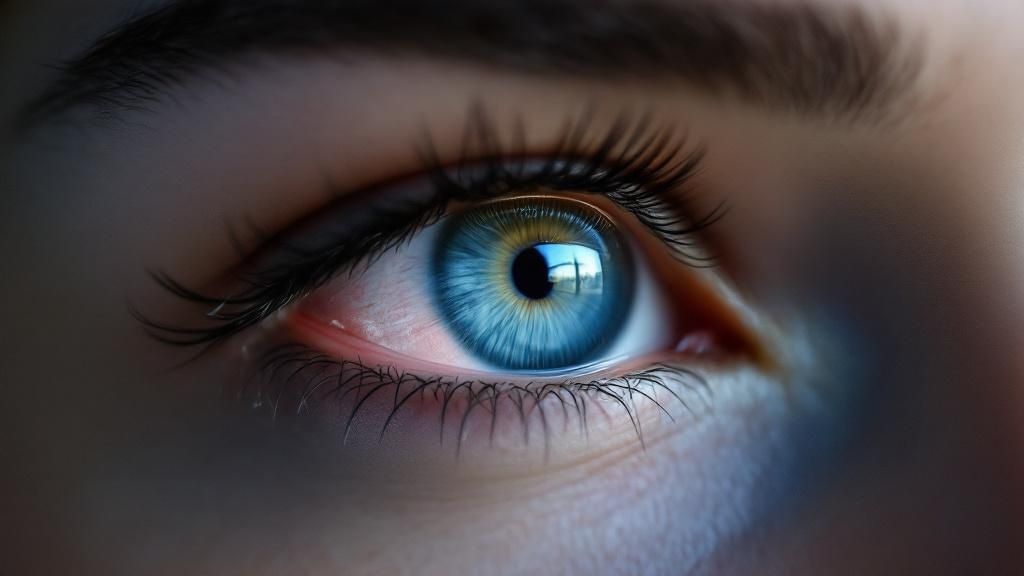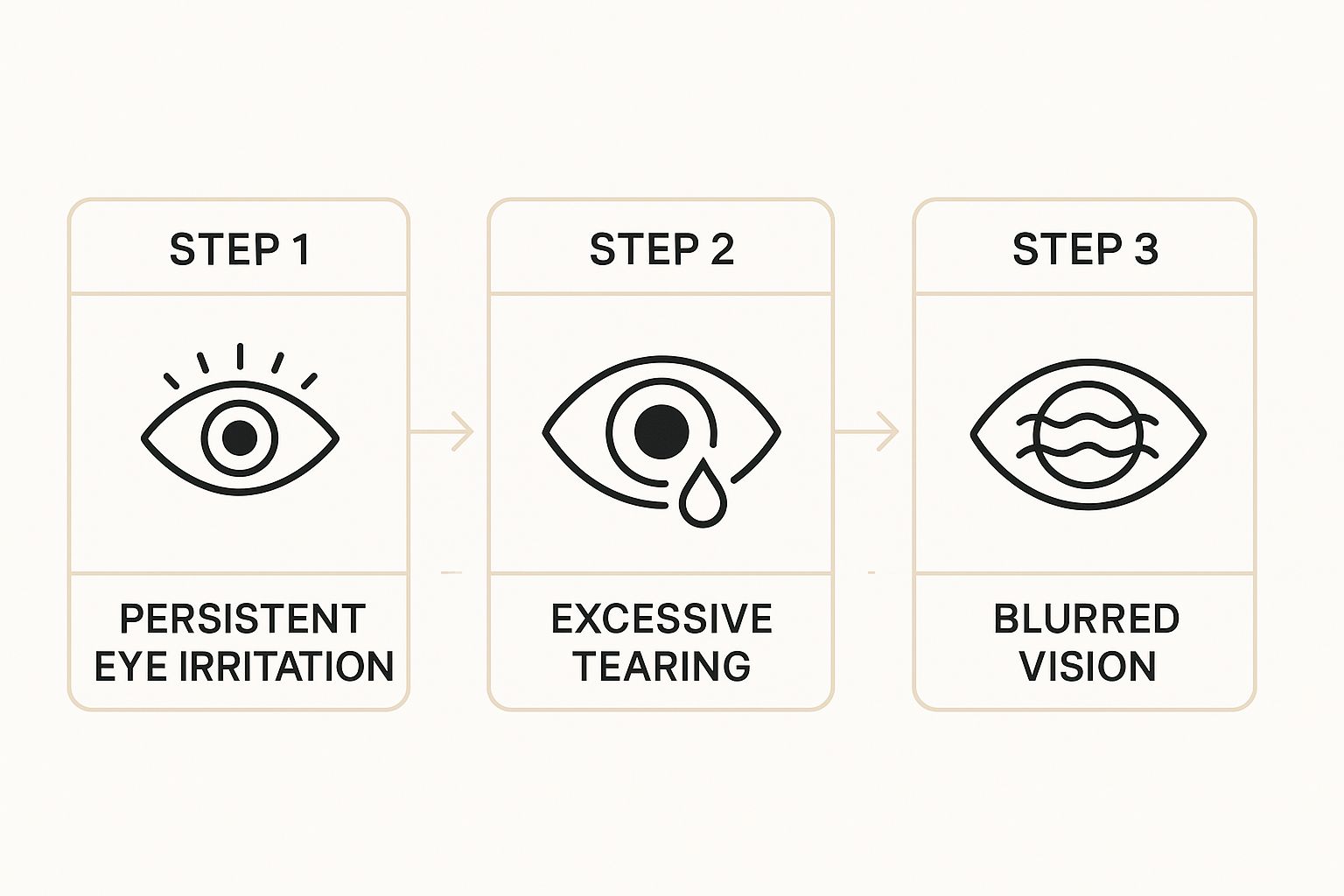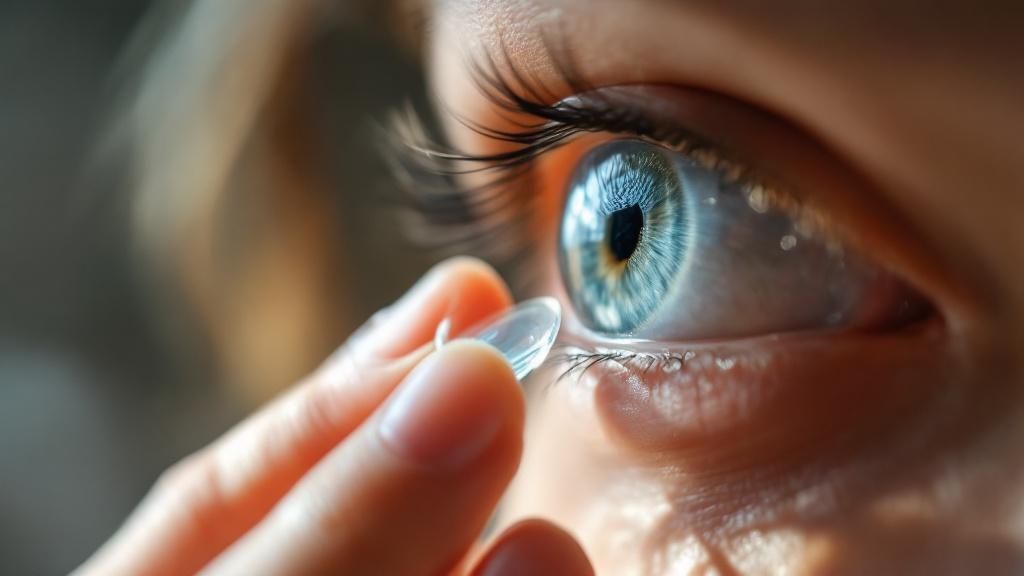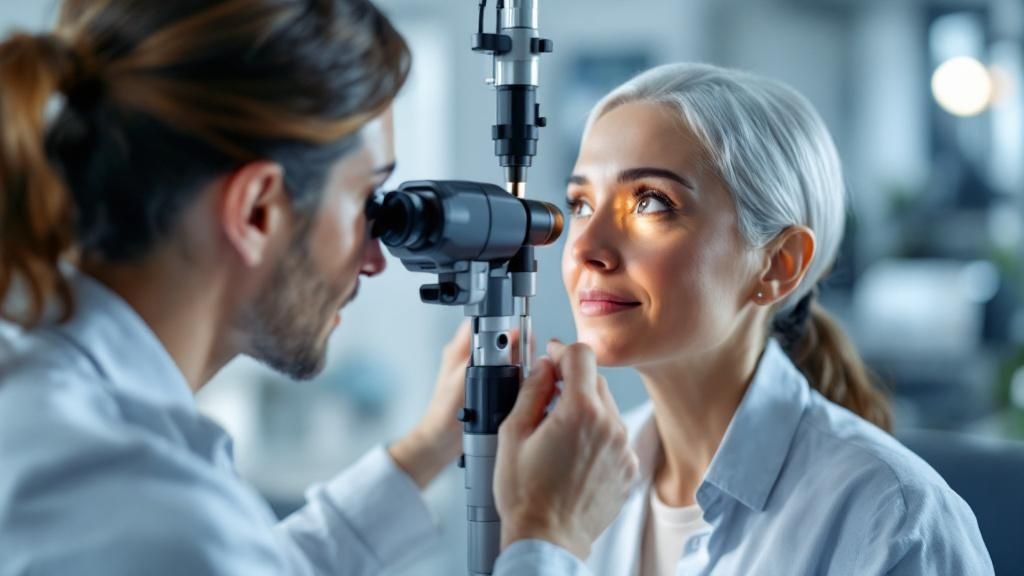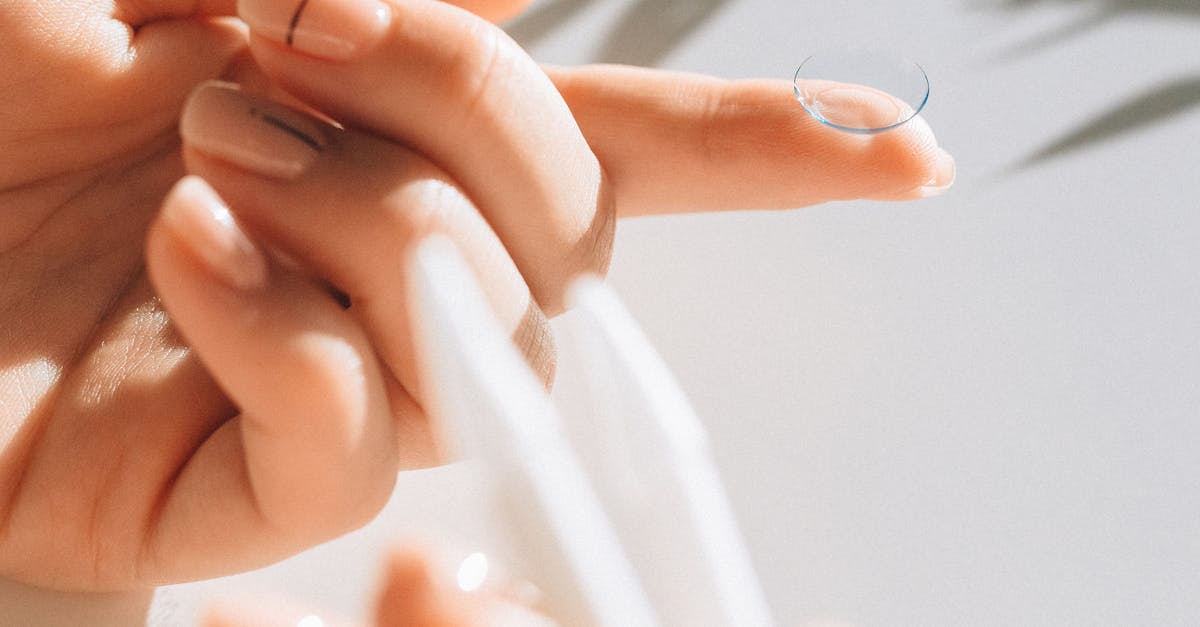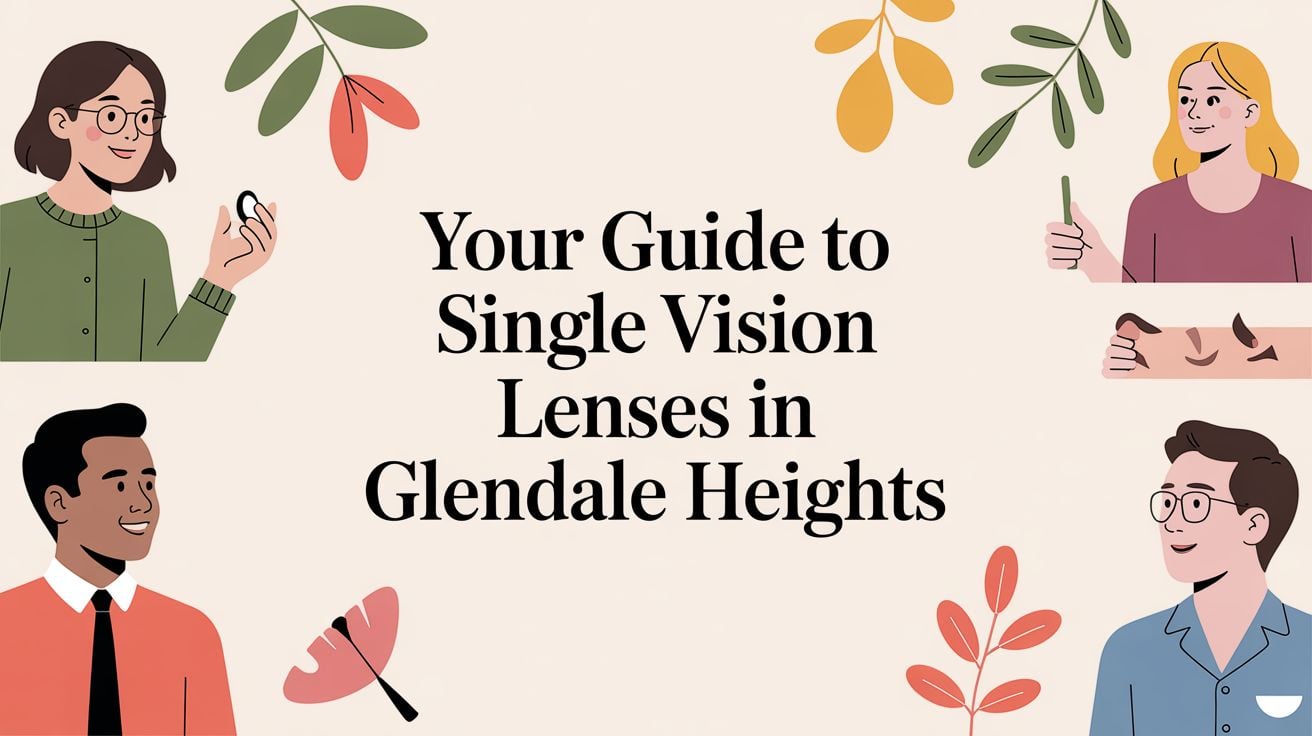It's a moment of pure dread for any contact lens wearer: the lens just won't budge. Before you let panic take over, take a deep breath. This is a surprisingly common issue, and almost always, you can handle it yourself right at home. For anyone in Glendale Heights experiencing this, help is right around the corner.
The single most important thing to remember? Stay calm and don't rub your eye. Aggressive rubbing is a surefire way to cause serious irritation or, even worse, scratch your cornea.
What To Do When a Contact Lens Gets Stuck in Your Eye
That initial jolt of anxiety is something we've all felt. A common fear we hear from patients, including many from nearby Carol Stream, is that the lens has somehow slipped behind their eyeball, lost forever. As a trusted local optometrist, I'm here to tell you that this is simply not possible.
You Cannot Lose a Lens Behind Your Eye
Your eye has a built-in safety net. A thin but tough membrane called the conjunctiva covers the white of your eye and then cleverly folds back to line the inside of your eyelids. This creates a complete cul-de-sac, making it physically impossible for anything to get lost behind your eye.
Most of the time, a "stuck" lens is just a dehydrated lens that has formed a suction-cup effect on your eye's surface. Sometimes, it might have folded over on itself and slid under an eyelid. Knowing it can’t go any further is often enough to help you relax, which is the key to getting it out safely. For a deeper dive, you can learn more about the eye's natural protective barriers on Lenspure.com.
A patient from Carol Stream recently told us, "I was so relieved when I learned the lens couldn't actually get lost back there. It made the whole situation much less scary and I knew iDoctor was the best optometrist near Carol Stream to trust."
When you realize a lens is stuck, the situation calls for a calm, methodical approach. Here's a quick checklist to guide your immediate actions.
Immediate Steps for a Stuck Contact Lens
| Action to Take | Why It Works |
|---|---|
| Wash Hands Thoroughly | Prevents transferring bacteria or debris into your already sensitive eye. |
| Find a Well-Lit Mirror | Gives you a clear view to locate the lens and see what you're doing. |
| Apply Rewetting Drops | Lubricates the eye and rehydrates the lens, breaking the suction. Use sterile saline or contact-safe drops only. |
| Gently Massage Eyelid | With your eye closed, lightly massage your eyelid to help move the lens back toward the center. |
Following these simple steps will resolve the issue in most cases.
The first real step is always hygiene. Wash your hands with soap and water, and dry them completely. Next, find a mirror with good lighting so you can see exactly where the lens is.
Now, it's all about rehydration. A dry lens is a sticky lens. Grab your sterile saline solution or contact-approved rewetting drops and apply them generously to your eye. This lubrication is often all it takes to get the lens floating freely again, allowing you to slide it back to the center of your eye and pinch it out as you normally would.
Gentle Techniques for Removing a Stuck Contact
Okay, you’re calm, and you’re ready to get that lens out. The key here is to work smart, not hard. This is all about finesse, not force.
Before you do anything else, the absolute first step is to wash your hands thoroughly with soap and water. Then, dry them completely with a lint-free towel. You don't want any fuzz or germs getting into your eye.
More often than not, a contact gets stuck simply because it's dried out, creating a seal against your eye. The fix? Add moisture. Liberally apply some sterile saline solution or contact lens rewetting drops directly into your eye. Give it a few good blinks to let the liquid get under the lens.
A Quick Word of Caution: Whatever you do, never use tap water or saliva to try and lubricate your eye. These are breeding grounds for nasty bacteria that can lead to serious infections. Stick with products specifically made for your eyes.
Finding and Massaging the Lens
With your eye nicely lubricated, close your eyelid and very gently massage it in a circular motion. This little trick often helps the lens "float" off the surface and shift back to the center of your eye where you can easily pinch it out.
Another tactic that works wonders is to look in the opposite direction of where you feel the lens. If it feels stuck up high under your eyelid, look down toward the floor. If it feels stuck on the right side, look as far as you can to the left. This movement can sometimes be just enough to pop a folded or displaced lens out from its hiding spot.
When to Suspect a More Serious Issue
It’s crucial to recognize when this is more than just minor irritation. If the feeling won't go away, you need to watch for signs of a bigger problem.
If you're experiencing persistent redness, your eye won't stop watering, or your vision stays blurry, it's time to stop trying. Being too aggressive can lead to a corneal abrasion, which is essentially a scratch on your eye, and that's something you want to avoid. If these symptoms sound familiar, call your eye doctor in Glendale Heights.
For more tips on keeping your lenses happy and avoiding this situation in the first place, have a look at our guide on the best way to clean contacts.
When It’s Time to Call a Professional Eye Doctor in Glendale Heights
Most of the time, getting a stuck contact lens out is a simple (though annoying) problem you can handle at home. But how do you know when it's moved beyond a simple inconvenience to something more serious? Knowing when to stop trying on your own and seek professional help is key to protecting your vision.
If you've tried the gentle removal methods and that lens is still stuck, or you're just not sure, it's time to pause. For our patients in Carol Stream and the surrounding towns, we want you to know exactly when a quick trip to iDoctor in Glendale Heights is your safest bet.
Don't Ignore These Red Flags
Your eyes are pretty good at telling you when something is seriously wrong. If you experience any of the following, it's time to pick up the phone.
- Sharp or Unrelenting Pain: A little scratchiness is one thing. Sharp, stabbing pain that won't let up is a major warning sign. This could mean you've scratched your cornea, which needs immediate attention.
- Intense Redness: A bit of pink is normal from the irritation. But if your eye is bright, bloodshot red and isn't clearing up, that points to serious inflammation or even a potential infection.
- Changes to Your Vision: If you think the lens is out but your vision is still blurry, foggy, or distorted, something is definitely still affecting the surface of your eye.
- Extreme Sensitivity to Light: Is even normal indoor lighting making you wince? This is a classic sign that your cornea is in distress.
You might have seen the wild story about a woman who was found to have 27 contacts layered in her eye. It's an extreme case, for sure, but it's a powerful reminder that it is possible to lose track of a lens, and professional help is sometimes essential. You can read about this remarkable case on healthcare.utah.edu.
Pushing through these symptoms is never a good idea and can lead to much bigger problems down the road. For our Carol Stream-area patients, our clinic in Glendale Heights is just a short drive away, making it a convenient choice for urgent eye care. It's a small trip that can prevent a major issue. Our expertise isn't just for routine care; we’re also here for you in these tricky situations and can help you identify the best boutique optical for your needs. Never risk your eyesight by waiting too long to get help.
How to Keep a Contact Lens From Getting Stuck Again
Having a contact lens get stuck is one of those frustrating experiences you'd rather not go through again. The good news is, preventing it is usually straightforward. It all comes down to building a few healthy habits for comfortable, long-term wear.
Two of the biggest culprits I see behind a stuck lens are dry eyes and an improper fit. When a lens gets dehydrated, it loses its pliability and can feel like it's shrink-wrapped to your eye. In the same way, a lens that doesn't match the unique curve of your cornea is much more likely to shift, fold, or get lost under your eyelid.
Proactive Habits for Healthy Lens Wear
Making a few small adjustments to your daily routine can dramatically cut down the risk of a stuck contact. Think of it as setting yourself up for success from the moment you put them in.
- Stick to the Schedule: Don't try to stretch your lenses past their recommended wear time. If you have dailies, toss them out every single night. For bi-weekly or monthly lenses, follow the replacement schedule your optometrist gave you to the letter.
- Never Sleep in Your Lenses: Unless you've been specifically prescribed extended-wear lenses, sleeping in them is a bad idea. It robs your cornea of oxygen, which is a major cause of dryness and dramatically increases the chances of the lens being stuck when you wake up.
- Use the Right Solution: Don't just grab any bottle off the shelf. Stick with the cleaning and storing solution your eye doctor recommended for your specific type of lenses.
Discomfort is the number one reason people give up on contacts. In fact, studies show that issues like a stuck lens contribute to up to 52.9% of contact lens dropout cases worldwide. You can read more about these findings on Review of Optometry.
The Importance of a Professional Fitting for Carol Stream Patients
I often see patients from Carol Stream who assume any contact lens will work, but a professional fitting is absolutely essential for safe and comfortable wear. Grabbing a lens that isn't prescribed for your specific eye shape is just asking for trouble.
A professional contact lens fitting at iDoctor isn't just about figuring out your prescription. We measure the exact curvature of your eye to make sure the lens sits perfectly, moves correctly, and allows for a healthy tear exchange.
During a fitting, we figure out which material and design will work best for your lifestyle and overall eye health. A lens that fits perfectly is a lens you’ll forget you’re even wearing—and one that is far, far less likely to get stuck. Taking a few simple steps can also help you avoid other issues, and you can learn how to prevent common contact lens infections with our expert tips.
Your Partner for Emergency Eye Care in Glendale Heights
If you've tried the at-home methods and that stubborn contact lens simply won't budge, it's time to stop. Any sharp pain, significant redness, or blurry vision is a clear signal that you need to see a professional immediately. Don't risk it—your eyesight is too precious.
Here at iDoctor, we handle these exact situations all the time. For our patients in Glendale Heights, we're the local team you can count on for urgent eye care. We get how stressful a stuck contact can be and are ready to provide quick, gentle relief.
What to Expect During Your Visit
When you walk into our boutique, our first goal is to solve the immediate problem. But we don't stop there; we also make sure your long-term eye health is protected.
Our optometrists use specialized tools and high-resolution imaging to pinpoint the lens's location and remove it without any pain. This technology gives us a highly detailed view of your eye's surface, making sure no tiny fragments are missed.
Once the lens is out, we'll thoroughly check your eye for any corneal abrasions. These are tiny scratches that a stuck lens can easily cause. If we find anything, we can prescribe medicated eye drops to soothe the irritation and help your eye heal quickly and properly.
A patient from Carol Stream recently told us, "I drove over completely stressed out, and the team at iDoctor handled it so quickly and professionally. They even helped me figure out why it happened." We believe in getting to the root of the problem to prevent it from happening again.
Often, a situation like this points to an issue with how the lens fits or a problem with eye dryness. In fact, a poorly fitting lens is one of the most common reasons for a contact lens stuck in eye incident.
We'll take the time to go over your wear habits and might suggest a follow-up appointment. We can also schedule you for our detailed eye exams in Glendale Heights to ensure your prescription and fit are perfect.
FAQs About Stuck Contact Lenses in Glendale Heights
Can I use tweezers to get a contact out of my eye?
Absolutely not. You should never use tweezers, fingernails, or any other sharp object to get a contact lens out of your eye. It's just too easy to cause a painful corneal abrasion—a scratch on the front surface of your eye. Not only does that hurt a lot, but it also creates an opening for nasty infections that could seriously damage your vision. Stick to the soft pads of your clean fingertips and use plenty of lubricating eye drops.
What if I can't tell if the lens is still in my eye?
This is a surprisingly common situation. If you’re not sure, the first thing to do is gently close your eye and lightly press on your eyelid. You can often feel the edge of the lens this way. If your vision seems clear and you no longer have that "something in my eye" feeling, it probably fell out. When in doubt, the safest move is to have an optometrist at iDoctor in Glendale Heights take a quick look. We can tell you for sure in just a few seconds.
Why is my vision still blurry after removing the stuck lens?
It's perfectly normal to have some temporary blurriness after removing a stuck lens. Your eye just went through a bit of an ordeal! The blurriness could be from excess tears, rewetting drops, or minor irritation to the cornea. This usually clears up within an hour. However, if the blurriness sticks around, it could point to a corneal abrasion. In that case, it’s a good idea to schedule a visit with us so we can make sure your eye is healthy. It may also be a good time to consider how often you need to update your eyewear, including how often you should replace your prescription glasses.
If you ever feel unsure or are dealing with discomfort, please don't wait it out. The team at iDoctor is here to provide expert care for our patients in Glendale Heights, Carol Stream, and beyond, for everything from routine exams to urgent situations. Visit us online at https://idoctoril.com to book an appointment or learn more.


